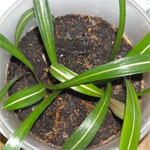
Amaryllis family. Homeland - Brazil. About 75 species are common in nature. The genus Griffinia is represented by 21 species and includes 2 subgenera Griffinia - with blue flowers (19 species) and Hyline with white (2 species). Plants bloom in spring or early summer.
Characteristic differences of this genus: There are 5 segments in the perianth, of which 4 are the same width, one is narrower. The segments are located in the perianth not symmetrically: 4 in the upper part, 1 in the lower. Bulbs with grayish-brown scales, shape resemble the bulbs of hippeastrums. The leaves are green, broad with a rounded apex, with dark spots or venation.
Griffinia hyacinthina - has non-large bulbs. The leaves are green (with mesh venation), oblong with a rounded apex, up to 20 cm long, narrowed at the base. Up to 15 light blue flowers are formed on a peduncle 50-60 cm long. The diameter of the flower is 7.5 cm. The petals are narrow, pointed. Flowering in spring and early summer. The fruit is a box.
Синонимы: Amaryllis dryades (Vell.), Amaryllis hyacinthina (Ker Gawl.), Griffinia dryades ((Vell.) M.Roem.), Griffinia hookeri (Kraenzl.), Griffinia hyacinthina ((Ker Gawl.) Ker Gawl.), Lycoris hyacinthina ((Ker Gawl.) Herb.), Hippeastrum dryads (Vell.) Kraenzl. The species was classified in 1815.
Griffinia - Care and Cultivation
Temperature: griffinia is thermophilic, during the growing season they grow optimally well at 25-32 ° C, in nature the temperature does not drop below 10 ° C.
- Dormancy period: plants of this genus do not have a pronounced dormancy period, however, with a decrease in lighting in the autumn-winter period, a decrease in temperature to 18-20 ° C is also required, while partial aging and death of leaves are allowed.
Lighting: Shade from direct sunlight. In natural conditions, griffinia grows in shaded areas of the rainforest, under the crown of trees, direct sun is destructive for it. Houses for her are suitable east and light northwest windows.
Watering: Quite plentiful all the time - should be moist at the back of the pot all the time, but dry well at the top. In winter, watering is somewhat reduced, allowing the earth to dry out, but not dry out!
Air humidity: Griffinia loves very humid air, spraying alone cannot be done here, an air humidifier or a wide tray of water will help in the heating season.
Fertilizer: once every one to two weeks with liquid fertilizer for flowering indoor plants (or for bulb plants), diluted in the concentration recommended by the manufacturer. Feeding begins as soon as the buds bloom, and ends when the leaves begin to wilt.
Transplantation: annually, after the end of flowering. Griffinia loves soils well drained and rich in organic matter. An example of a soil mixture: 2 parts of peat land, 1 parts of humus and 1 parts of sand. Griffinia are planted in small pots, about 10-12 cm in diameter, while the bulb is completely buried in the ground, but the neck of the bulb should be at or slightly higher than the soil level. Good drainage to the bottom of the pot is mandatory.
Reproduction: daughter bulbs during transplantation, seeds. Separated children are planted in the prepared soil mixture in separate pots. Fresh seeds in the spring are planted in wide plates, in peat soil, sprinkled with earth, and moistened from a spray bottle. Do not allow the temperature to drop below 18 ° C. The soil should always be slightly moistened, do not allow re-drying or stagnation of moisture. Seed germination lasts 6-8 weeks, and griffinia will bloom, only at the age of 3-4 years.
Classification of the Amaryllis family
Hippeastrum Frequently Asked Questions
